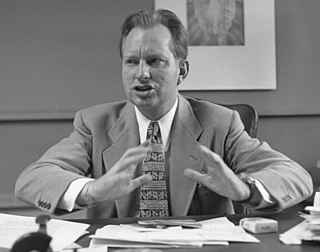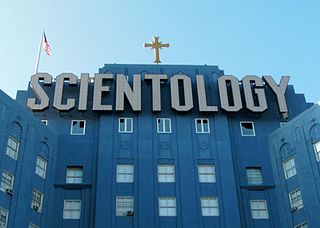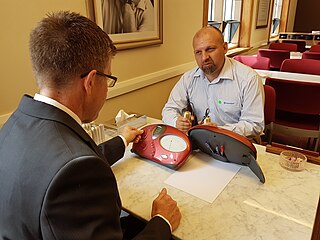
Dianetics is a set of ideas and practices, invented in 1950 by science fiction writer L. Ron Hubbard, regarding the human mind. Dianetics was originally conceived as a form of psychological treatment, but was rejected by the psychological and medical establishments as pseudoscientific. It was the precursor to Scientology and has since been incorporated into it. It involves a process referred to as "auditing", which utilizes an electrical resistance meter, ostensibly to remove emotional burdens and "cure" people from their troubles.

Lafayette Ronald Hubbard was an American author and the founder of Scientology. A prolific writer of pulp science fiction and fantasy novels in his early career, in 1950 he authored Dianetics: The Modern Science of Mental Health and established organizations to promote and practice Dianetics techniques. Hubbard created Scientology in 1952 after losing the intellectual rights to his literature on Dianetics in bankruptcy. He would lead the Church of Scientology – variously described as a cult, a new religious movement, or a business – until his death in 1986.

Followers of the Scientology movement maintain a wide variety of beliefs and practices. The core belief holds that a human is an immortal, spiritual being (thetan) that is resident in a physical body. The thetan has had innumerable past lives, some of which, preceding the thetan's arrival on Earth, were lived in extraterrestrial cultures. Based on case studies at advanced levels, it is predicted that any Scientologist undergoing auditing will eventually come across and recount a common series of past-life events.

In Scientology, the concept of the thetan is similar to the concept of self, or the spirit or soul as found in several belief systems. The term is derived from the Greek letter Θ, theta, which in Scientology beliefs represents "the source of life, or life itself." In Scientology it is believed that it is the thetan, not the central nervous system, which commands the body.
In Scientology, an implant is a form of thought insertion, similar to an engram but done deliberately and with evil intent. It is "an intentional installation of fixed ideas, contra-survival to the thetan".

The E-Meter is an electronic device used in Scientology that allegedly "registers emotional reactions". After claims by L. Ron Hubbard that the procedures of auditing, which used the E-Meter, could help heal diseases, the E-Meter became the subject of litigation. Since then, the Church of Scientology publishes disclaimers declaring that the E-Meter "by itself does nothing", is incapable of improving health, and is used solely for spiritual purposes.
The reactive mind is a concept in Scientology formulated by L. Ron Hubbard, referring to that portion of the human mind that is unconscious and operates on stimulus-response, to which Hubbard attributed most mental, emotional, and psychosomatic ailments:
What can it do? It can give a man arthritis, bursitis, asthma, allergies, sinusitis, coronary trouble, high blood pressure and so on, down the whole catalog of psychosomatic ills, adding a few more which were never specifically classified as psychosomatic, such as the common cold.

Auditing, also known as processing, is the core practice of Scientology. Scientologists believe that the role of auditing is to improve a person's abilities and to reduce or eliminate their neuroses. The Scientologist is asked questions about past events while holding two metal cylinders attached to an electrical resistance meter (galvanometer) with a dial. The term "auditing" was coined by L. Ron Hubbard in his 1950 book Dianetics: The Modern Science of Mental Health, which describes the process.

Dianetics: The Modern Science of Mental Health, sometimes abbreviated as DMSMH, is a book by L. Ron Hubbard describing a pseudoscientific set of ideas, Dianetics, that would later become part of Scientology. Hubbard claimed to have developed it from a combination of personal experience, basic principles of Eastern philosophy and the work of Sigmund Freud. The book is considered part of Scientology's canon. It is colloquially referred to by Scientologists as Book One. The book launched the movement, which Hubbard later characterised as a religion, in 1950. As of 2013, the Scientology organization's publishing arm, New Era Publications, sells the book in English and in 50 other languages.
In Dianetics and Scientology, Clear is a status afforded to followers by the Scientology organization, or by other Scientologists, after they complete certain activities. It is one of the major ostensible "states" practitioners strive to reach on their way up what the Scientologists call the Bridge to Total Freedom. Scientology followers are given the status of Clear when a person is deemed to be free of the influence of engrams – supposed unwanted emotions or painful traumas which Scientology claims are not readily available to the conscious mind. Scientologists believe that human beings accumulate anxieties, psychosomatic illnesses, and aberration due to receiving engrams throughout their current or past lives, and that by applying Dianetics, every single person can obtain the status of Clear.

MEST is an acronym for matter, energy, space and time, and means the physical universe. It was coined in 1950 by Scientology founder L. Ron Hubbard, and is spoken as a word rather than spelling out the letters.

A Piece of Blue Sky: Scientology, Dianetics and L. Ron Hubbard Exposed is a 1990 book about L. Ron Hubbard and the development of Dianetics and Scientology, authored by British former Scientologist Jon Atack. It was republished in 2013 with the title Let's sell these people A Piece of Blue Sky: Hubbard, Dianetics and Scientology. The title originates from a quote of Hubbard from 1950: an associate of Hubbard's noted him saying that he wanted to sell potential members "a piece of blue sky".

This bibliography of Scientology includes Scientology and Dianetics-related books, periodicals and other issues authored by L. Ron Hubbard and those produced by the Church of Scientology and its related organizations. Books bearing L. Ron Hubbard's name are considered texts of Scientology's canon.
The amount of material on Dianetics and Scientology is extensive, to say the least. This material is composed of books by L. Ron Hubbard ; compilations of his works; taped lectures; auditor training materials ; course packages; booklets; a large number of magazines and annuals; and video recordings of the major annual events.

An incident in Scientology beliefs is something that happened to a person that continues to have a grip on their mind or spirit, and is negatively affecting them. It could be an accident or traumatic event that includes pain and subconscious commands, whether from this life or in past lives. Scientology auditing procedures are used to locate incidents in the mind, and relieve them.

A Doctor's Report on Dianetics: Theory and Therapy is a non-fiction book analyzing Dianetics. The book was authored by physician Joseph Augustus Winter, with an introduction by German gestalt therapy research psychiatrist Frederick Perls.

The Bridge to Total Freedom, also known as the Classification, Gradation and Awareness Chart, is Scientology's primary action plan and road map to guide a person through the sequential steps to attain Scientology's concept of spiritual freedom. Displayed in every Scientology organization as an enormous poster using red ink, the comprehensive chart contains almost every service available within Scientology. Each step on the Bridge has a monetary cost.

The relationship between Scientology and religious groups is very complex. There are significant contradictions between Scientology and most religions, especially the major monotheistic religions. Scientology texts written by its inventor, L. Ron Hubbard, claim that it is fully compatible with all existing major world religions, and that it does not conflict with them or their religious practices. Members are not allowed to engage in other similar mental therapies or procedures, religious or otherwise.

Scientology is in part derived from, and shares elements with, a number of esoteric or occult systems. The extent of the influence of specific occult belief systems on Scientology is a subject of debate amongst scholars.

Scientology has a complex relationship with concepts of gender roles and discrimination, as while the core beliefs of Scientology hold humans to consist of genderless Thetans, the Church and other Scientology organizations have frequently been noted as upholding discriminatory policies or views based on the original writings of founder L. Ron Hubbard.
From 1950 to 1953, Hubbard led the Dianetics Movement which published, promoted and provided an alternative talk therapy called "auditing".









